Government Policy Report: Restorative Justice vs Incarceration
VerifiedAdded on 2023/01/18
|8
|2585
|60
Report
AI Summary
This report delves into the critical issue of human rights for young criminals in Australia, evaluating two primary government policy approaches: restorative justice and incarceration. The introduction highlights the vulnerability of young offenders and their limited protections under human rights conventions, focusing on the age range of 10 to 17. The body of the report examines restorative justice, its focus on rehabilitation and community reconciliation, and its application in Australia. It includes media discussions, the protection of human rights, and evidence of its effectiveness, along with circumstances where it is appropriate or inappropriate. The report then analyzes incarceration, its philosophies of violence prevention and punishment, and media perspectives. It discusses the policy's impact on human rights, the effectiveness of incarceration, and appropriate and inappropriate circumstances for its application. The action plan advocates for restorative justice as a more effective approach, emphasizing rehabilitation and the protection of human rights for both offenders and victims. The conclusion summarizes the findings, highlighting the importance of government policies in minimizing crime and ensuring public freedom.
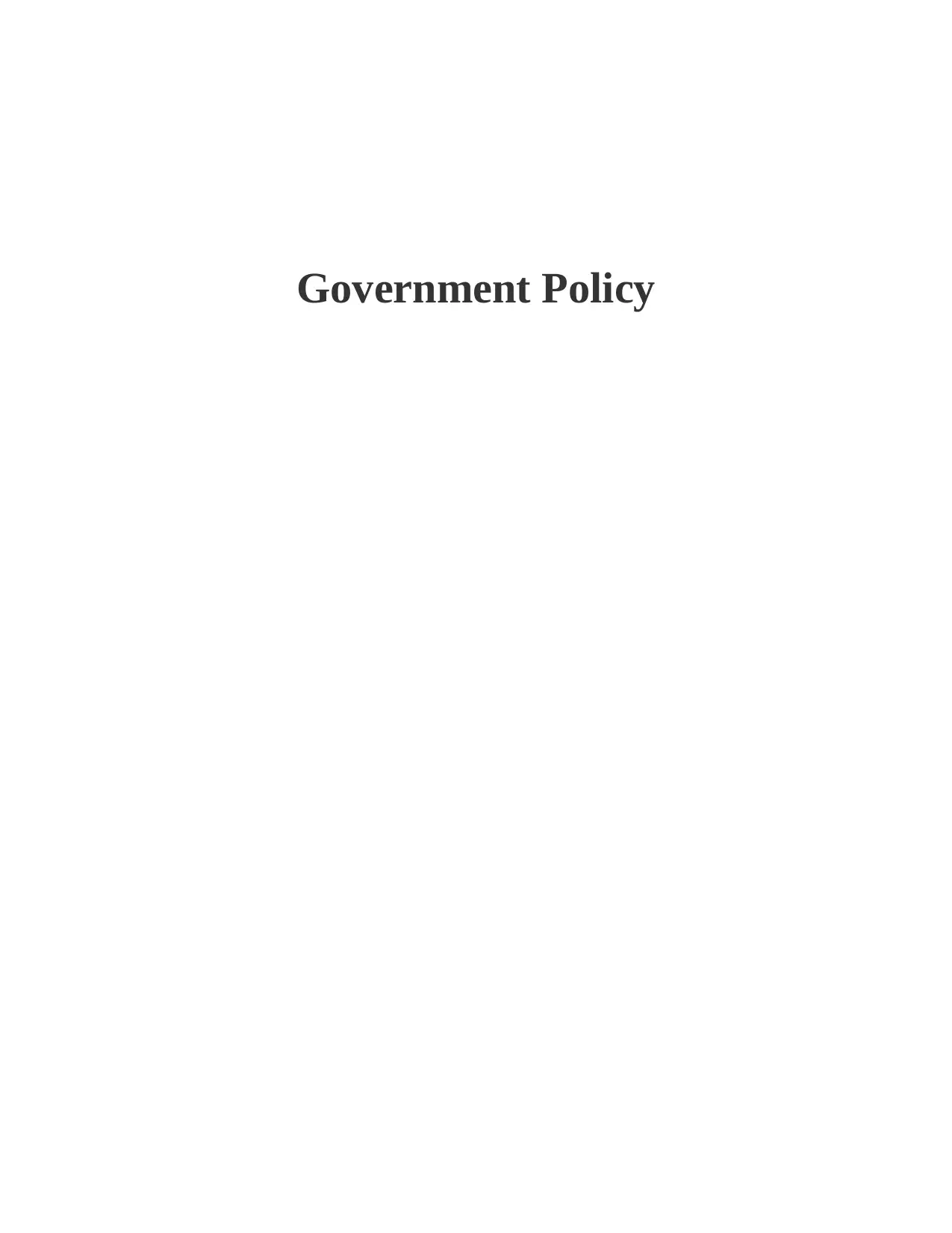
Government Policy
Paraphrase This Document
Need a fresh take? Get an instant paraphrase of this document with our AI Paraphraser
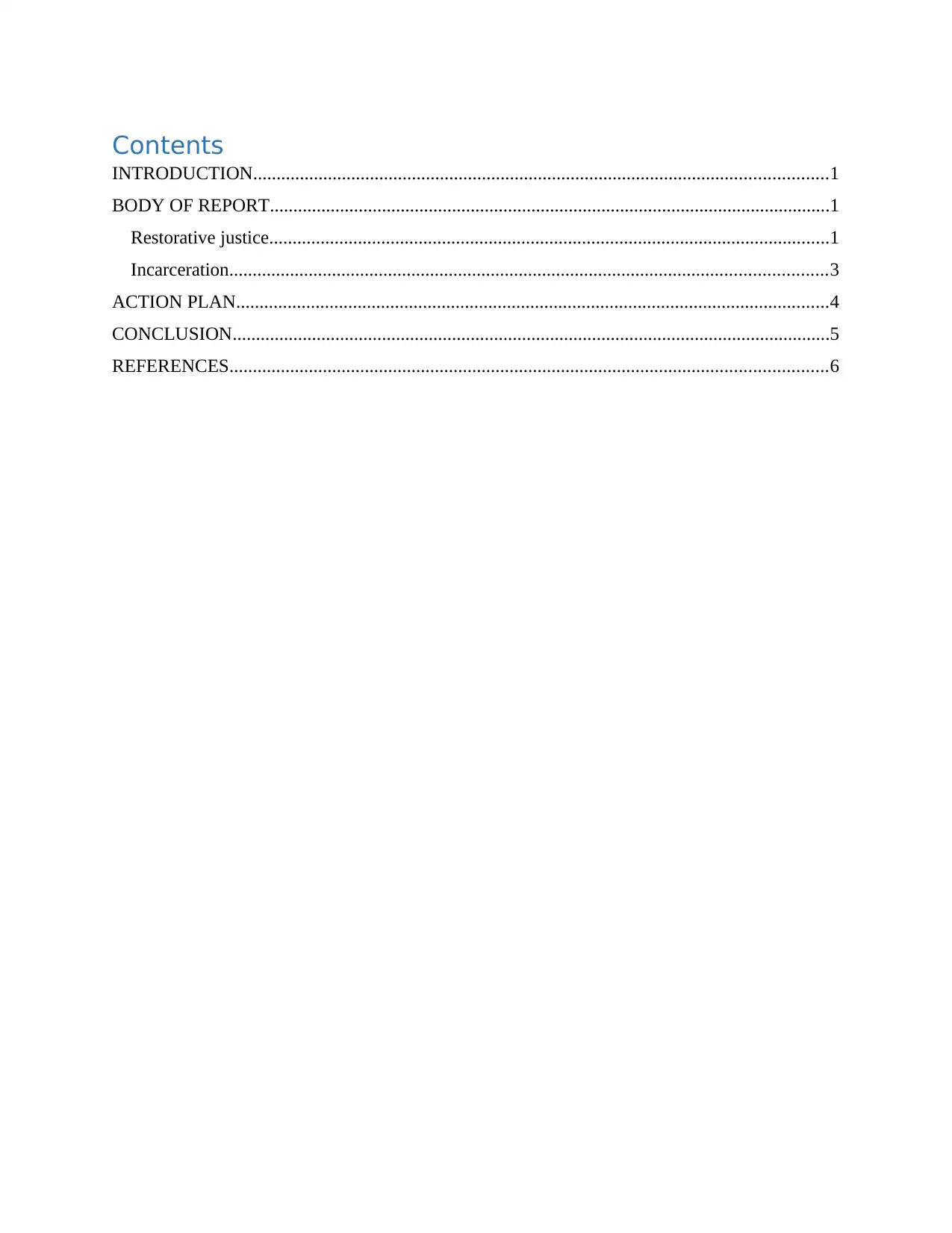
Contents
INTRODUCTION...........................................................................................................................1
BODY OF REPORT........................................................................................................................1
Restorative justice........................................................................................................................1
Incarceration................................................................................................................................3
ACTION PLAN...............................................................................................................................4
CONCLUSION................................................................................................................................5
REFERENCES................................................................................................................................6
INTRODUCTION...........................................................................................................................1
BODY OF REPORT........................................................................................................................1
Restorative justice........................................................................................................................1
Incarceration................................................................................................................................3
ACTION PLAN...............................................................................................................................4
CONCLUSION................................................................................................................................5
REFERENCES................................................................................................................................6
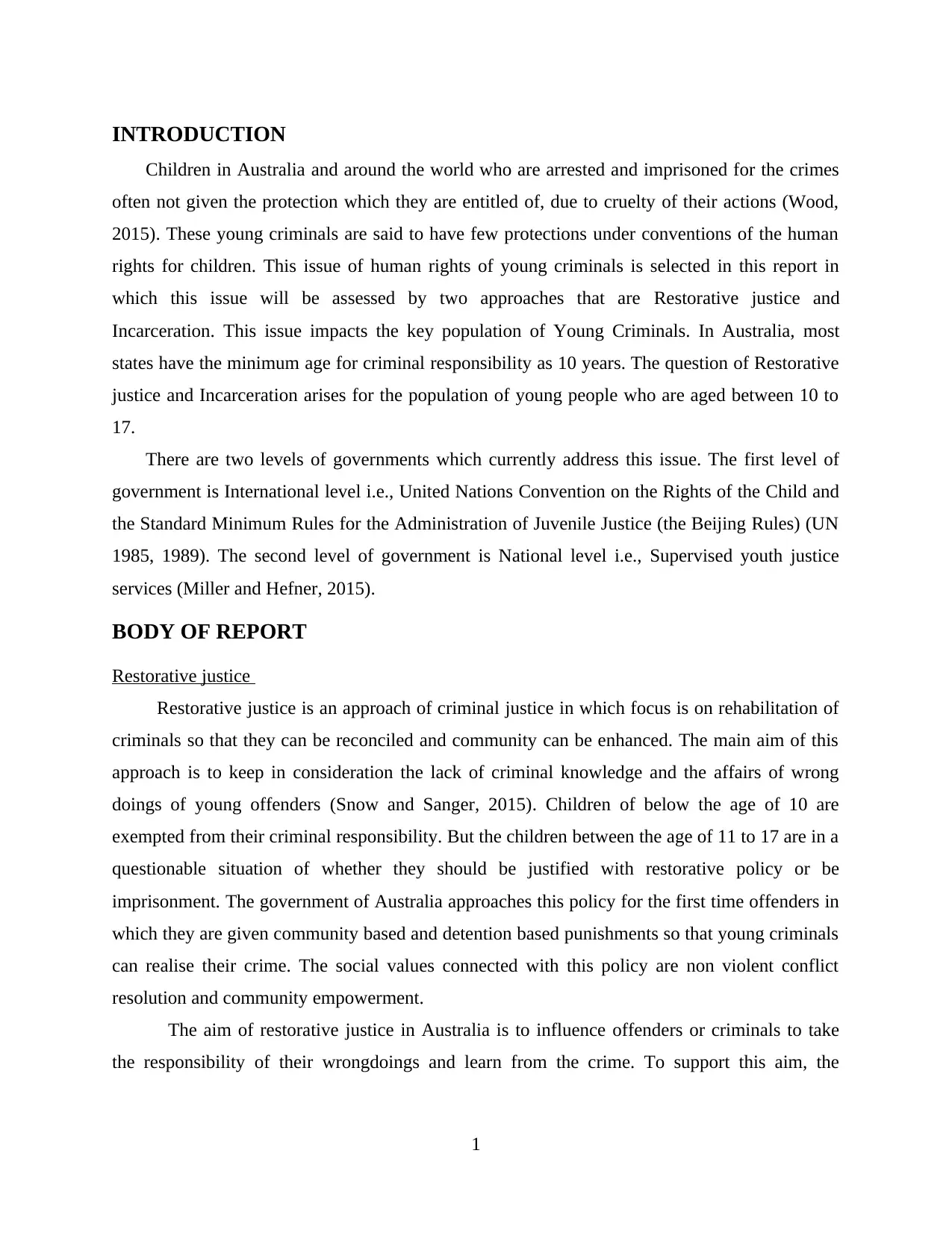
INTRODUCTION
Children in Australia and around the world who are arrested and imprisoned for the crimes
often not given the protection which they are entitled of, due to cruelty of their actions (Wood,
2015). These young criminals are said to have few protections under conventions of the human
rights for children. This issue of human rights of young criminals is selected in this report in
which this issue will be assessed by two approaches that are Restorative justice and
Incarceration. This issue impacts the key population of Young Criminals. In Australia, most
states have the minimum age for criminal responsibility as 10 years. The question of Restorative
justice and Incarceration arises for the population of young people who are aged between 10 to
17.
There are two levels of governments which currently address this issue. The first level of
government is International level i.e., United Nations Convention on the Rights of the Child and
the Standard Minimum Rules for the Administration of Juvenile Justice (the Beijing Rules) (UN
1985, 1989). The second level of government is National level i.e., Supervised youth justice
services (Miller and Hefner, 2015).
BODY OF REPORT
Restorative justice
Restorative justice is an approach of criminal justice in which focus is on rehabilitation of
criminals so that they can be reconciled and community can be enhanced. The main aim of this
approach is to keep in consideration the lack of criminal knowledge and the affairs of wrong
doings of young offenders (Snow and Sanger, 2015). Children of below the age of 10 are
exempted from their criminal responsibility. But the children between the age of 11 to 17 are in a
questionable situation of whether they should be justified with restorative policy or be
imprisonment. The government of Australia approaches this policy for the first time offenders in
which they are given community based and detention based punishments so that young criminals
can realise their crime. The social values connected with this policy are non violent conflict
resolution and community empowerment.
The aim of restorative justice in Australia is to influence offenders or criminals to take
the responsibility of their wrongdoings and learn from the crime. To support this aim, the
1
Children in Australia and around the world who are arrested and imprisoned for the crimes
often not given the protection which they are entitled of, due to cruelty of their actions (Wood,
2015). These young criminals are said to have few protections under conventions of the human
rights for children. This issue of human rights of young criminals is selected in this report in
which this issue will be assessed by two approaches that are Restorative justice and
Incarceration. This issue impacts the key population of Young Criminals. In Australia, most
states have the minimum age for criminal responsibility as 10 years. The question of Restorative
justice and Incarceration arises for the population of young people who are aged between 10 to
17.
There are two levels of governments which currently address this issue. The first level of
government is International level i.e., United Nations Convention on the Rights of the Child and
the Standard Minimum Rules for the Administration of Juvenile Justice (the Beijing Rules) (UN
1985, 1989). The second level of government is National level i.e., Supervised youth justice
services (Miller and Hefner, 2015).
BODY OF REPORT
Restorative justice
Restorative justice is an approach of criminal justice in which focus is on rehabilitation of
criminals so that they can be reconciled and community can be enhanced. The main aim of this
approach is to keep in consideration the lack of criminal knowledge and the affairs of wrong
doings of young offenders (Snow and Sanger, 2015). Children of below the age of 10 are
exempted from their criminal responsibility. But the children between the age of 11 to 17 are in a
questionable situation of whether they should be justified with restorative policy or be
imprisonment. The government of Australia approaches this policy for the first time offenders in
which they are given community based and detention based punishments so that young criminals
can realise their crime. The social values connected with this policy are non violent conflict
resolution and community empowerment.
The aim of restorative justice in Australia is to influence offenders or criminals to take
the responsibility of their wrongdoings and learn from the crime. To support this aim, the
1
⊘ This is a preview!⊘
Do you want full access?
Subscribe today to unlock all pages.

Trusted by 1+ million students worldwide
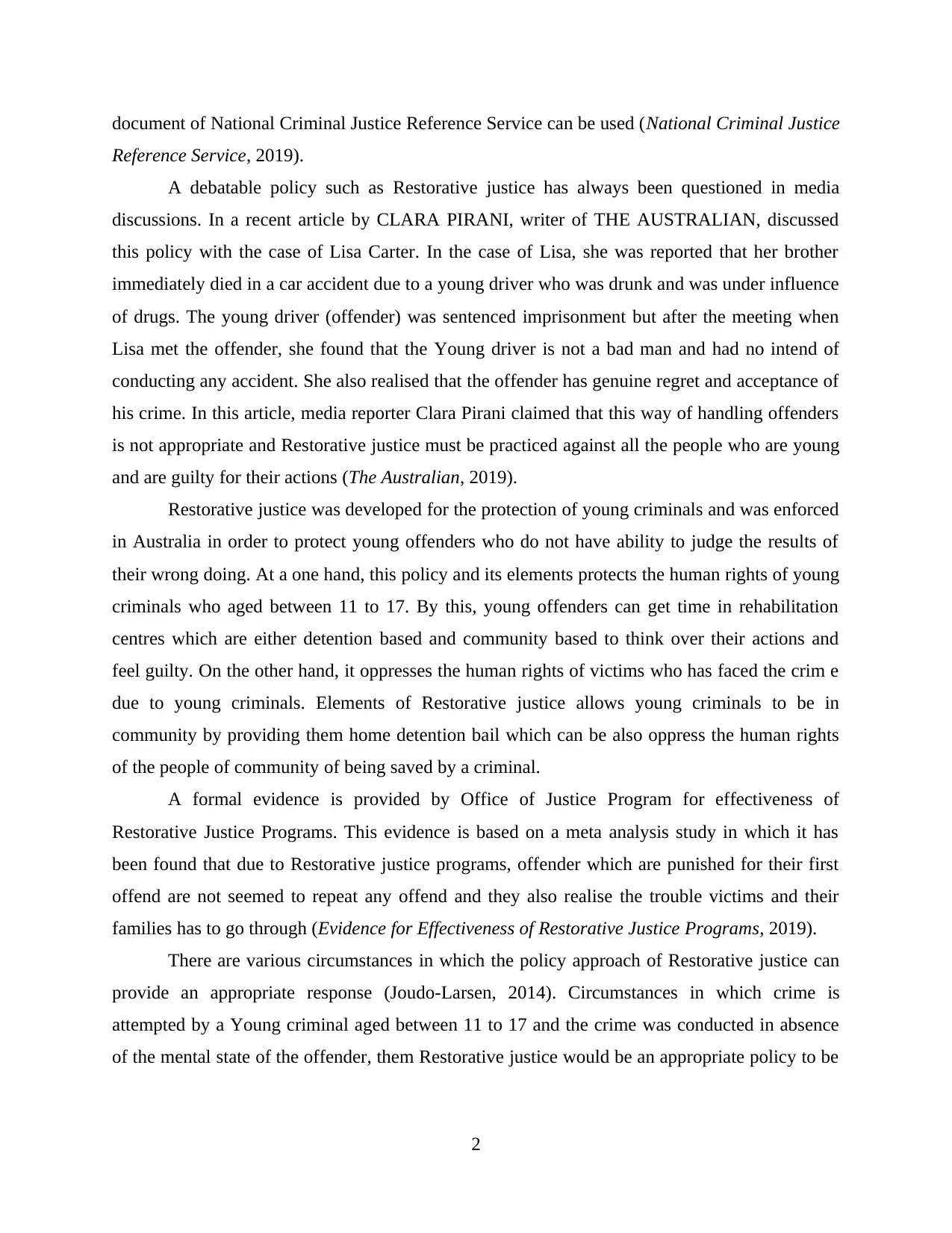
document of National Criminal Justice Reference Service can be used (National Criminal Justice
Reference Service, 2019).
A debatable policy such as Restorative justice has always been questioned in media
discussions. In a recent article by CLARA PIRANI, writer of THE AUSTRALIAN, discussed
this policy with the case of Lisa Carter. In the case of Lisa, she was reported that her brother
immediately died in a car accident due to a young driver who was drunk and was under influence
of drugs. The young driver (offender) was sentenced imprisonment but after the meeting when
Lisa met the offender, she found that the Young driver is not a bad man and had no intend of
conducting any accident. She also realised that the offender has genuine regret and acceptance of
his crime. In this article, media reporter Clara Pirani claimed that this way of handling offenders
is not appropriate and Restorative justice must be practiced against all the people who are young
and are guilty for their actions (The Australian, 2019).
Restorative justice was developed for the protection of young criminals and was enforced
in Australia in order to protect young offenders who do not have ability to judge the results of
their wrong doing. At a one hand, this policy and its elements protects the human rights of young
criminals who aged between 11 to 17. By this, young offenders can get time in rehabilitation
centres which are either detention based and community based to think over their actions and
feel guilty. On the other hand, it oppresses the human rights of victims who has faced the crim e
due to young criminals. Elements of Restorative justice allows young criminals to be in
community by providing them home detention bail which can be also oppress the human rights
of the people of community of being saved by a criminal.
A formal evidence is provided by Office of Justice Program for effectiveness of
Restorative Justice Programs. This evidence is based on a meta analysis study in which it has
been found that due to Restorative justice programs, offender which are punished for their first
offend are not seemed to repeat any offend and they also realise the trouble victims and their
families has to go through (Evidence for Effectiveness of Restorative Justice Programs, 2019).
There are various circumstances in which the policy approach of Restorative justice can
provide an appropriate response (Joudo-Larsen, 2014). Circumstances in which crime is
attempted by a Young criminal aged between 11 to 17 and the crime was conducted in absence
of the mental state of the offender, them Restorative justice would be an appropriate policy to be
2
Reference Service, 2019).
A debatable policy such as Restorative justice has always been questioned in media
discussions. In a recent article by CLARA PIRANI, writer of THE AUSTRALIAN, discussed
this policy with the case of Lisa Carter. In the case of Lisa, she was reported that her brother
immediately died in a car accident due to a young driver who was drunk and was under influence
of drugs. The young driver (offender) was sentenced imprisonment but after the meeting when
Lisa met the offender, she found that the Young driver is not a bad man and had no intend of
conducting any accident. She also realised that the offender has genuine regret and acceptance of
his crime. In this article, media reporter Clara Pirani claimed that this way of handling offenders
is not appropriate and Restorative justice must be practiced against all the people who are young
and are guilty for their actions (The Australian, 2019).
Restorative justice was developed for the protection of young criminals and was enforced
in Australia in order to protect young offenders who do not have ability to judge the results of
their wrong doing. At a one hand, this policy and its elements protects the human rights of young
criminals who aged between 11 to 17. By this, young offenders can get time in rehabilitation
centres which are either detention based and community based to think over their actions and
feel guilty. On the other hand, it oppresses the human rights of victims who has faced the crim e
due to young criminals. Elements of Restorative justice allows young criminals to be in
community by providing them home detention bail which can be also oppress the human rights
of the people of community of being saved by a criminal.
A formal evidence is provided by Office of Justice Program for effectiveness of
Restorative Justice Programs. This evidence is based on a meta analysis study in which it has
been found that due to Restorative justice programs, offender which are punished for their first
offend are not seemed to repeat any offend and they also realise the trouble victims and their
families has to go through (Evidence for Effectiveness of Restorative Justice Programs, 2019).
There are various circumstances in which the policy approach of Restorative justice can
provide an appropriate response (Joudo-Larsen, 2014). Circumstances in which crime is
attempted by a Young criminal aged between 11 to 17 and the crime was conducted in absence
of the mental state of the offender, them Restorative justice would be an appropriate policy to be
2
Paraphrase This Document
Need a fresh take? Get an instant paraphrase of this document with our AI Paraphraser
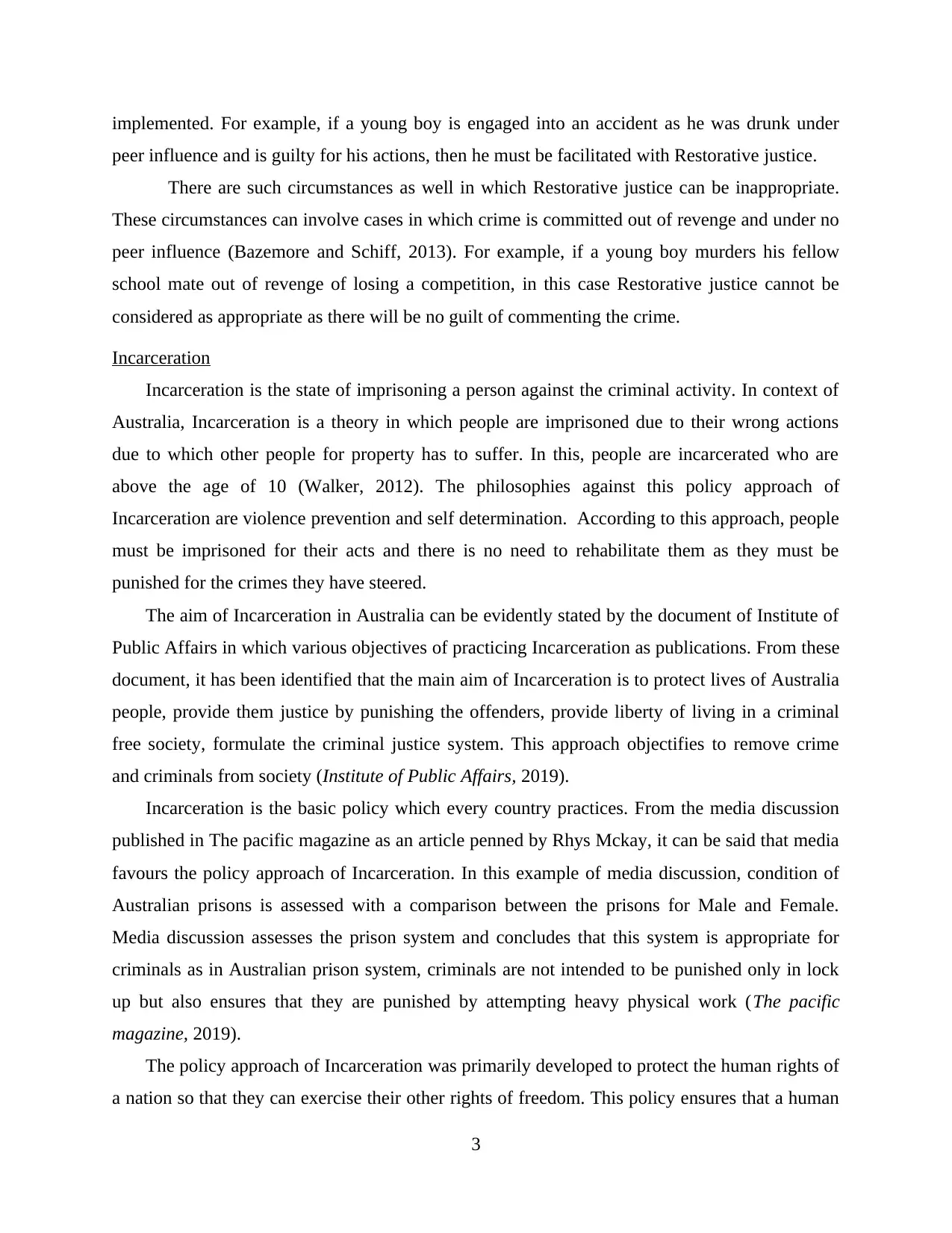
implemented. For example, if a young boy is engaged into an accident as he was drunk under
peer influence and is guilty for his actions, then he must be facilitated with Restorative justice.
There are such circumstances as well in which Restorative justice can be inappropriate.
These circumstances can involve cases in which crime is committed out of revenge and under no
peer influence (Bazemore and Schiff, 2013). For example, if a young boy murders his fellow
school mate out of revenge of losing a competition, in this case Restorative justice cannot be
considered as appropriate as there will be no guilt of commenting the crime.
Incarceration
Incarceration is the state of imprisoning a person against the criminal activity. In context of
Australia, Incarceration is a theory in which people are imprisoned due to their wrong actions
due to which other people for property has to suffer. In this, people are incarcerated who are
above the age of 10 (Walker, 2012). The philosophies against this policy approach of
Incarceration are violence prevention and self determination. According to this approach, people
must be imprisoned for their acts and there is no need to rehabilitate them as they must be
punished for the crimes they have steered.
The aim of Incarceration in Australia can be evidently stated by the document of Institute of
Public Affairs in which various objectives of practicing Incarceration as publications. From these
document, it has been identified that the main aim of Incarceration is to protect lives of Australia
people, provide them justice by punishing the offenders, provide liberty of living in a criminal
free society, formulate the criminal justice system. This approach objectifies to remove crime
and criminals from society (Institute of Public Affairs, 2019).
Incarceration is the basic policy which every country practices. From the media discussion
published in The pacific magazine as an article penned by Rhys Mckay, it can be said that media
favours the policy approach of Incarceration. In this example of media discussion, condition of
Australian prisons is assessed with a comparison between the prisons for Male and Female.
Media discussion assesses the prison system and concludes that this system is appropriate for
criminals as in Australian prison system, criminals are not intended to be punished only in lock
up but also ensures that they are punished by attempting heavy physical work (The pacific
magazine, 2019).
The policy approach of Incarceration was primarily developed to protect the human rights of
a nation so that they can exercise their other rights of freedom. This policy ensures that a human
3
peer influence and is guilty for his actions, then he must be facilitated with Restorative justice.
There are such circumstances as well in which Restorative justice can be inappropriate.
These circumstances can involve cases in which crime is committed out of revenge and under no
peer influence (Bazemore and Schiff, 2013). For example, if a young boy murders his fellow
school mate out of revenge of losing a competition, in this case Restorative justice cannot be
considered as appropriate as there will be no guilt of commenting the crime.
Incarceration
Incarceration is the state of imprisoning a person against the criminal activity. In context of
Australia, Incarceration is a theory in which people are imprisoned due to their wrong actions
due to which other people for property has to suffer. In this, people are incarcerated who are
above the age of 10 (Walker, 2012). The philosophies against this policy approach of
Incarceration are violence prevention and self determination. According to this approach, people
must be imprisoned for their acts and there is no need to rehabilitate them as they must be
punished for the crimes they have steered.
The aim of Incarceration in Australia can be evidently stated by the document of Institute of
Public Affairs in which various objectives of practicing Incarceration as publications. From these
document, it has been identified that the main aim of Incarceration is to protect lives of Australia
people, provide them justice by punishing the offenders, provide liberty of living in a criminal
free society, formulate the criminal justice system. This approach objectifies to remove crime
and criminals from society (Institute of Public Affairs, 2019).
Incarceration is the basic policy which every country practices. From the media discussion
published in The pacific magazine as an article penned by Rhys Mckay, it can be said that media
favours the policy approach of Incarceration. In this example of media discussion, condition of
Australian prisons is assessed with a comparison between the prisons for Male and Female.
Media discussion assesses the prison system and concludes that this system is appropriate for
criminals as in Australian prison system, criminals are not intended to be punished only in lock
up but also ensures that they are punished by attempting heavy physical work (The pacific
magazine, 2019).
The policy approach of Incarceration was primarily developed to protect the human rights of
a nation so that they can exercise their other rights of freedom. This policy ensures that a human
3
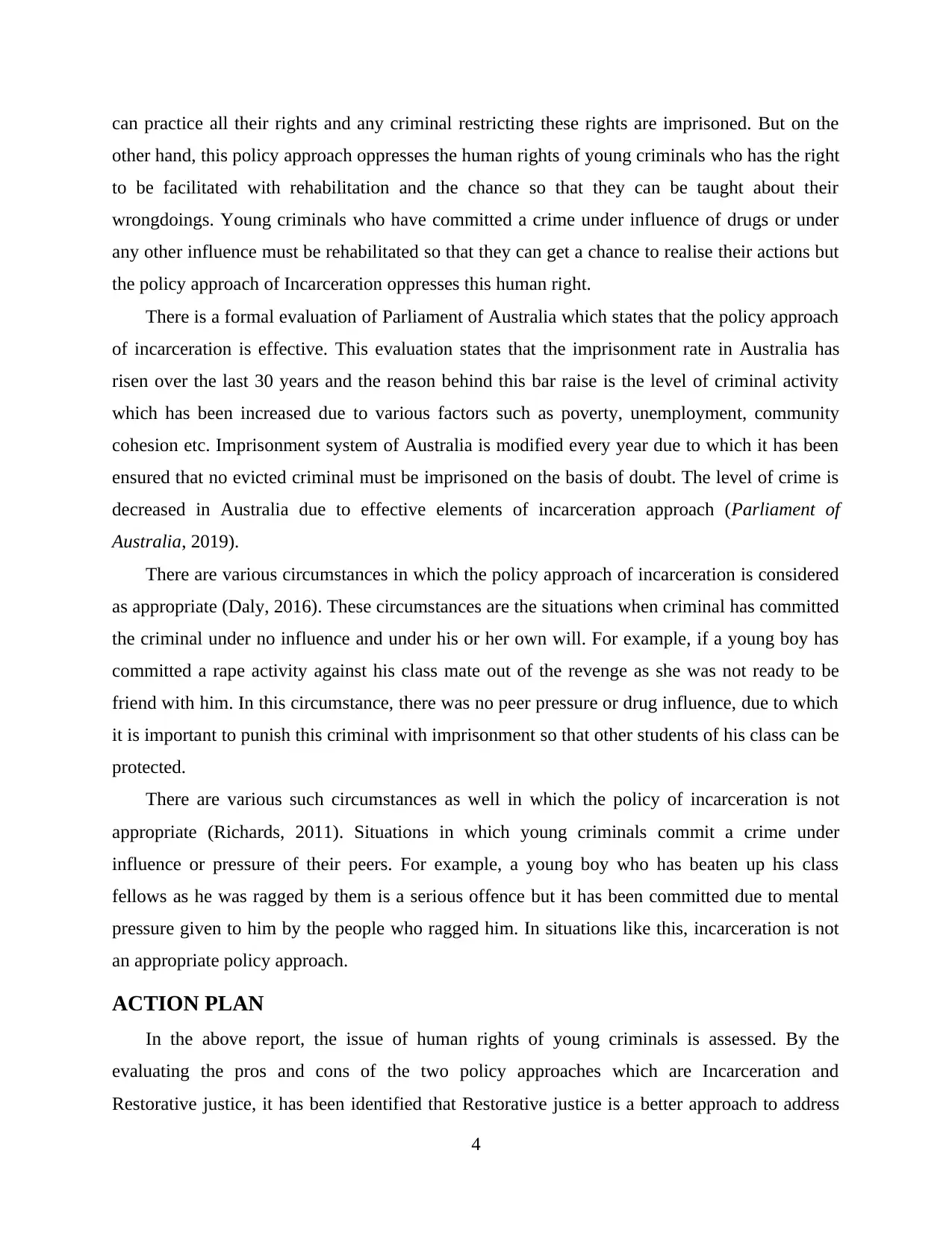
can practice all their rights and any criminal restricting these rights are imprisoned. But on the
other hand, this policy approach oppresses the human rights of young criminals who has the right
to be facilitated with rehabilitation and the chance so that they can be taught about their
wrongdoings. Young criminals who have committed a crime under influence of drugs or under
any other influence must be rehabilitated so that they can get a chance to realise their actions but
the policy approach of Incarceration oppresses this human right.
There is a formal evaluation of Parliament of Australia which states that the policy approach
of incarceration is effective. This evaluation states that the imprisonment rate in Australia has
risen over the last 30 years and the reason behind this bar raise is the level of criminal activity
which has been increased due to various factors such as poverty, unemployment, community
cohesion etc. Imprisonment system of Australia is modified every year due to which it has been
ensured that no evicted criminal must be imprisoned on the basis of doubt. The level of crime is
decreased in Australia due to effective elements of incarceration approach (Parliament of
Australia, 2019).
There are various circumstances in which the policy approach of incarceration is considered
as appropriate (Daly, 2016). These circumstances are the situations when criminal has committed
the criminal under no influence and under his or her own will. For example, if a young boy has
committed a rape activity against his class mate out of the revenge as she was not ready to be
friend with him. In this circumstance, there was no peer pressure or drug influence, due to which
it is important to punish this criminal with imprisonment so that other students of his class can be
protected.
There are various such circumstances as well in which the policy of incarceration is not
appropriate (Richards, 2011). Situations in which young criminals commit a crime under
influence or pressure of their peers. For example, a young boy who has beaten up his class
fellows as he was ragged by them is a serious offence but it has been committed due to mental
pressure given to him by the people who ragged him. In situations like this, incarceration is not
an appropriate policy approach.
ACTION PLAN
In the above report, the issue of human rights of young criminals is assessed. By the
evaluating the pros and cons of the two policy approaches which are Incarceration and
Restorative justice, it has been identified that Restorative justice is a better approach to address
4
other hand, this policy approach oppresses the human rights of young criminals who has the right
to be facilitated with rehabilitation and the chance so that they can be taught about their
wrongdoings. Young criminals who have committed a crime under influence of drugs or under
any other influence must be rehabilitated so that they can get a chance to realise their actions but
the policy approach of Incarceration oppresses this human right.
There is a formal evaluation of Parliament of Australia which states that the policy approach
of incarceration is effective. This evaluation states that the imprisonment rate in Australia has
risen over the last 30 years and the reason behind this bar raise is the level of criminal activity
which has been increased due to various factors such as poverty, unemployment, community
cohesion etc. Imprisonment system of Australia is modified every year due to which it has been
ensured that no evicted criminal must be imprisoned on the basis of doubt. The level of crime is
decreased in Australia due to effective elements of incarceration approach (Parliament of
Australia, 2019).
There are various circumstances in which the policy approach of incarceration is considered
as appropriate (Daly, 2016). These circumstances are the situations when criminal has committed
the criminal under no influence and under his or her own will. For example, if a young boy has
committed a rape activity against his class mate out of the revenge as she was not ready to be
friend with him. In this circumstance, there was no peer pressure or drug influence, due to which
it is important to punish this criminal with imprisonment so that other students of his class can be
protected.
There are various such circumstances as well in which the policy of incarceration is not
appropriate (Richards, 2011). Situations in which young criminals commit a crime under
influence or pressure of their peers. For example, a young boy who has beaten up his class
fellows as he was ragged by them is a serious offence but it has been committed due to mental
pressure given to him by the people who ragged him. In situations like this, incarceration is not
an appropriate policy approach.
ACTION PLAN
In the above report, the issue of human rights of young criminals is assessed. By the
evaluating the pros and cons of the two policy approaches which are Incarceration and
Restorative justice, it has been identified that Restorative justice is a better approach to address
4
⊘ This is a preview!⊘
Do you want full access?
Subscribe today to unlock all pages.

Trusted by 1+ million students worldwide
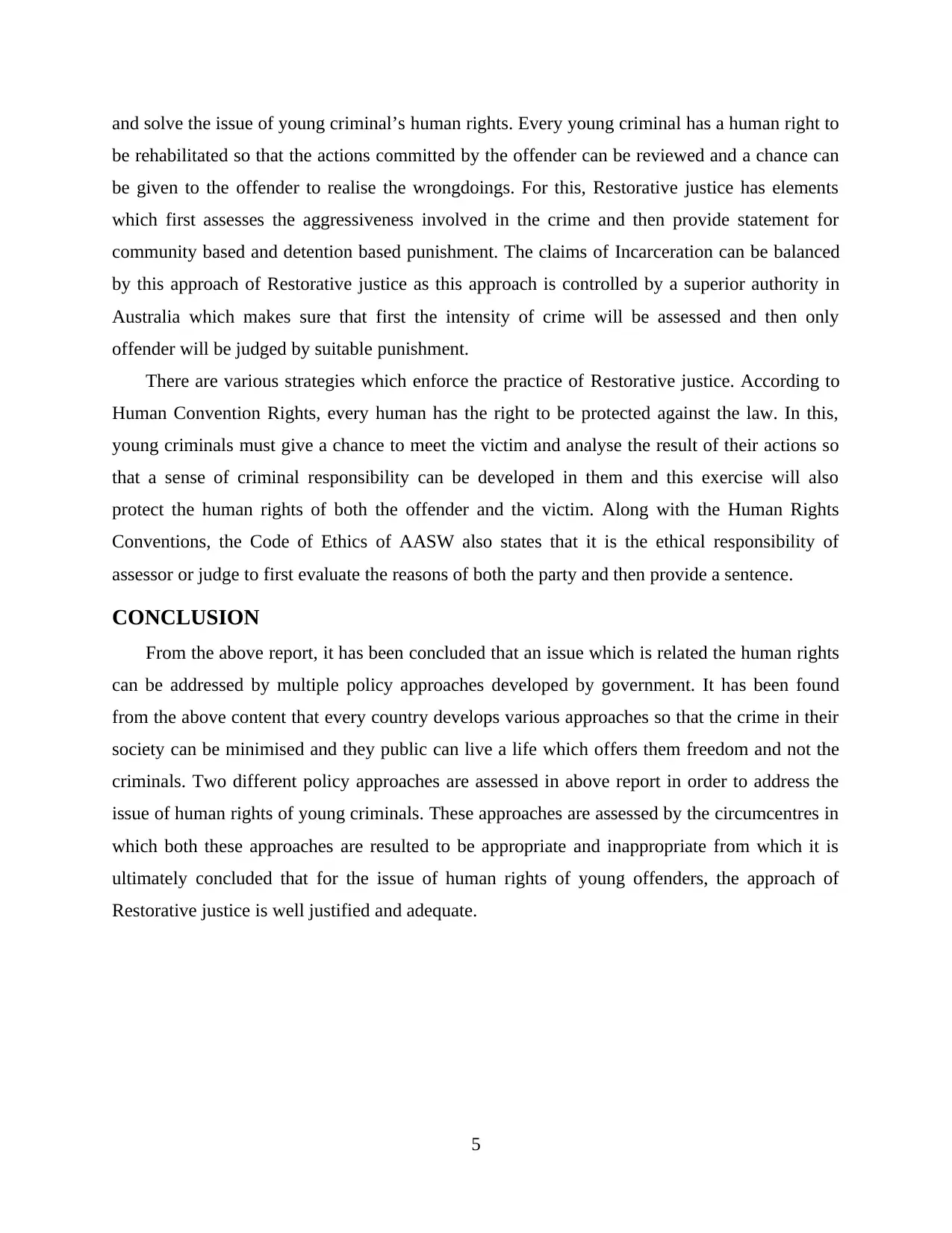
and solve the issue of young criminal’s human rights. Every young criminal has a human right to
be rehabilitated so that the actions committed by the offender can be reviewed and a chance can
be given to the offender to realise the wrongdoings. For this, Restorative justice has elements
which first assesses the aggressiveness involved in the crime and then provide statement for
community based and detention based punishment. The claims of Incarceration can be balanced
by this approach of Restorative justice as this approach is controlled by a superior authority in
Australia which makes sure that first the intensity of crime will be assessed and then only
offender will be judged by suitable punishment.
There are various strategies which enforce the practice of Restorative justice. According to
Human Convention Rights, every human has the right to be protected against the law. In this,
young criminals must give a chance to meet the victim and analyse the result of their actions so
that a sense of criminal responsibility can be developed in them and this exercise will also
protect the human rights of both the offender and the victim. Along with the Human Rights
Conventions, the Code of Ethics of AASW also states that it is the ethical responsibility of
assessor or judge to first evaluate the reasons of both the party and then provide a sentence.
CONCLUSION
From the above report, it has been concluded that an issue which is related the human rights
can be addressed by multiple policy approaches developed by government. It has been found
from the above content that every country develops various approaches so that the crime in their
society can be minimised and they public can live a life which offers them freedom and not the
criminals. Two different policy approaches are assessed in above report in order to address the
issue of human rights of young criminals. These approaches are assessed by the circumcentres in
which both these approaches are resulted to be appropriate and inappropriate from which it is
ultimately concluded that for the issue of human rights of young offenders, the approach of
Restorative justice is well justified and adequate.
5
be rehabilitated so that the actions committed by the offender can be reviewed and a chance can
be given to the offender to realise the wrongdoings. For this, Restorative justice has elements
which first assesses the aggressiveness involved in the crime and then provide statement for
community based and detention based punishment. The claims of Incarceration can be balanced
by this approach of Restorative justice as this approach is controlled by a superior authority in
Australia which makes sure that first the intensity of crime will be assessed and then only
offender will be judged by suitable punishment.
There are various strategies which enforce the practice of Restorative justice. According to
Human Convention Rights, every human has the right to be protected against the law. In this,
young criminals must give a chance to meet the victim and analyse the result of their actions so
that a sense of criminal responsibility can be developed in them and this exercise will also
protect the human rights of both the offender and the victim. Along with the Human Rights
Conventions, the Code of Ethics of AASW also states that it is the ethical responsibility of
assessor or judge to first evaluate the reasons of both the party and then provide a sentence.
CONCLUSION
From the above report, it has been concluded that an issue which is related the human rights
can be addressed by multiple policy approaches developed by government. It has been found
from the above content that every country develops various approaches so that the crime in their
society can be minimised and they public can live a life which offers them freedom and not the
criminals. Two different policy approaches are assessed in above report in order to address the
issue of human rights of young criminals. These approaches are assessed by the circumcentres in
which both these approaches are resulted to be appropriate and inappropriate from which it is
ultimately concluded that for the issue of human rights of young offenders, the approach of
Restorative justice is well justified and adequate.
5
Paraphrase This Document
Need a fresh take? Get an instant paraphrase of this document with our AI Paraphraser
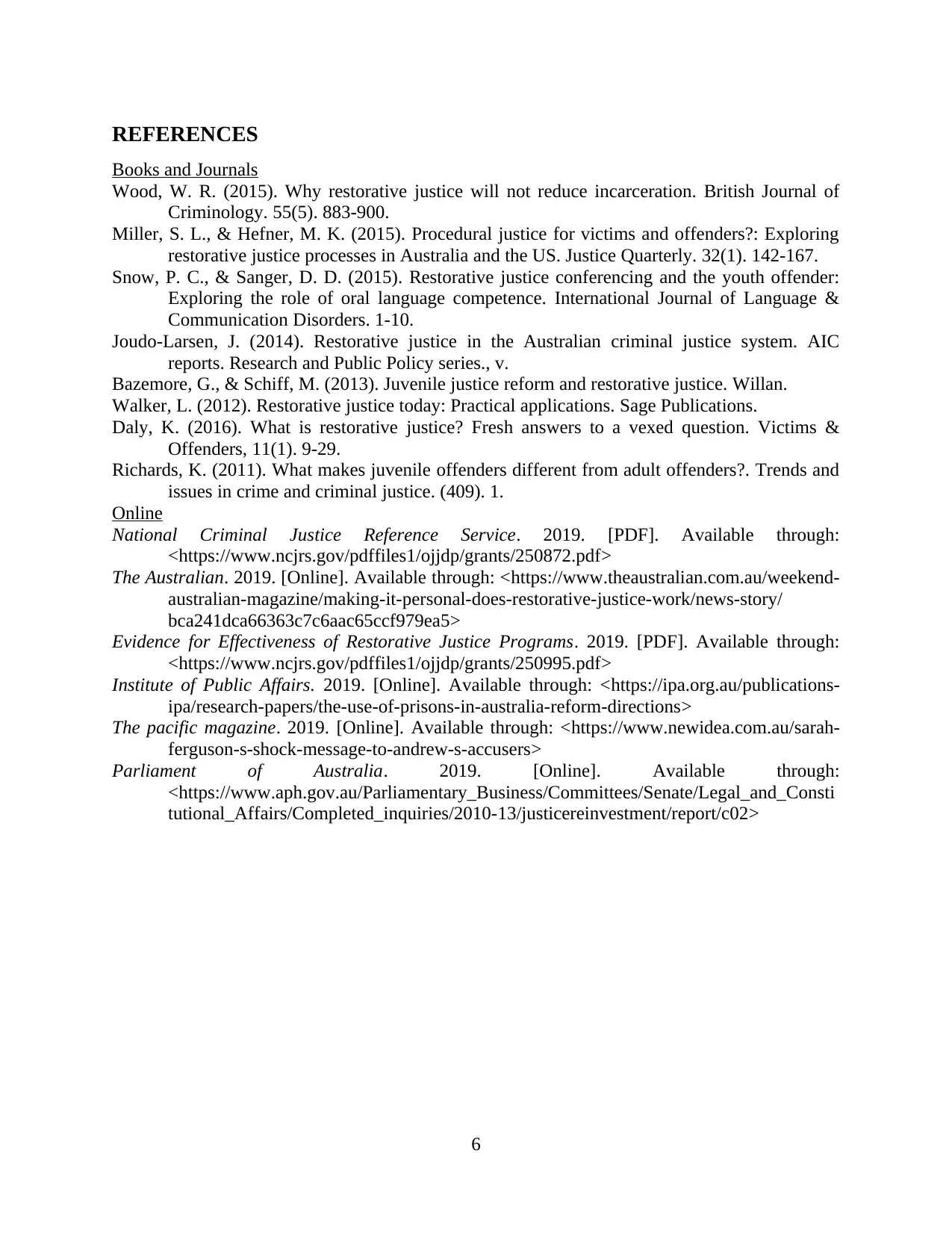
REFERENCES
Books and Journals
Wood, W. R. (2015). Why restorative justice will not reduce incarceration. British Journal of
Criminology. 55(5). 883-900.
Miller, S. L., & Hefner, M. K. (2015). Procedural justice for victims and offenders?: Exploring
restorative justice processes in Australia and the US. Justice Quarterly. 32(1). 142-167.
Snow, P. C., & Sanger, D. D. (2015). Restorative justice conferencing and the youth offender:
Exploring the role of oral language competence. International Journal of Language &
Communication Disorders. 1-10.
Joudo-Larsen, J. (2014). Restorative justice in the Australian criminal justice system. AIC
reports. Research and Public Policy series., v.
Bazemore, G., & Schiff, M. (2013). Juvenile justice reform and restorative justice. Willan.
Walker, L. (2012). Restorative justice today: Practical applications. Sage Publications.
Daly, K. (2016). What is restorative justice? Fresh answers to a vexed question. Victims &
Offenders, 11(1). 9-29.
Richards, K. (2011). What makes juvenile offenders different from adult offenders?. Trends and
issues in crime and criminal justice. (409). 1.
Online
National Criminal Justice Reference Service. 2019. [PDF]. Available through:
<https://www.ncjrs.gov/pdffiles1/ojjdp/grants/250872.pdf>
The Australian. 2019. [Online]. Available through: <https://www.theaustralian.com.au/weekend-
australian-magazine/making-it-personal-does-restorative-justice-work/news-story/
bca241dca66363c7c6aac65ccf979ea5>
Evidence for Effectiveness of Restorative Justice Programs. 2019. [PDF]. Available through:
<https://www.ncjrs.gov/pdffiles1/ojjdp/grants/250995.pdf>
Institute of Public Affairs. 2019. [Online]. Available through: <https://ipa.org.au/publications-
ipa/research-papers/the-use-of-prisons-in-australia-reform-directions>
The pacific magazine. 2019. [Online]. Available through: <https://www.newidea.com.au/sarah-
ferguson-s-shock-message-to-andrew-s-accusers>
Parliament of Australia. 2019. [Online]. Available through:
<https://www.aph.gov.au/Parliamentary_Business/Committees/Senate/Legal_and_Consti
tutional_Affairs/Completed_inquiries/2010-13/justicereinvestment/report/c02>
6
Books and Journals
Wood, W. R. (2015). Why restorative justice will not reduce incarceration. British Journal of
Criminology. 55(5). 883-900.
Miller, S. L., & Hefner, M. K. (2015). Procedural justice for victims and offenders?: Exploring
restorative justice processes in Australia and the US. Justice Quarterly. 32(1). 142-167.
Snow, P. C., & Sanger, D. D. (2015). Restorative justice conferencing and the youth offender:
Exploring the role of oral language competence. International Journal of Language &
Communication Disorders. 1-10.
Joudo-Larsen, J. (2014). Restorative justice in the Australian criminal justice system. AIC
reports. Research and Public Policy series., v.
Bazemore, G., & Schiff, M. (2013). Juvenile justice reform and restorative justice. Willan.
Walker, L. (2012). Restorative justice today: Practical applications. Sage Publications.
Daly, K. (2016). What is restorative justice? Fresh answers to a vexed question. Victims &
Offenders, 11(1). 9-29.
Richards, K. (2011). What makes juvenile offenders different from adult offenders?. Trends and
issues in crime and criminal justice. (409). 1.
Online
National Criminal Justice Reference Service. 2019. [PDF]. Available through:
<https://www.ncjrs.gov/pdffiles1/ojjdp/grants/250872.pdf>
The Australian. 2019. [Online]. Available through: <https://www.theaustralian.com.au/weekend-
australian-magazine/making-it-personal-does-restorative-justice-work/news-story/
bca241dca66363c7c6aac65ccf979ea5>
Evidence for Effectiveness of Restorative Justice Programs. 2019. [PDF]. Available through:
<https://www.ncjrs.gov/pdffiles1/ojjdp/grants/250995.pdf>
Institute of Public Affairs. 2019. [Online]. Available through: <https://ipa.org.au/publications-
ipa/research-papers/the-use-of-prisons-in-australia-reform-directions>
The pacific magazine. 2019. [Online]. Available through: <https://www.newidea.com.au/sarah-
ferguson-s-shock-message-to-andrew-s-accusers>
Parliament of Australia. 2019. [Online]. Available through:
<https://www.aph.gov.au/Parliamentary_Business/Committees/Senate/Legal_and_Consti
tutional_Affairs/Completed_inquiries/2010-13/justicereinvestment/report/c02>
6
1 out of 8
Related Documents
Your All-in-One AI-Powered Toolkit for Academic Success.
+13062052269
info@desklib.com
Available 24*7 on WhatsApp / Email
![[object Object]](/_next/static/media/star-bottom.7253800d.svg)
Unlock your academic potential
Copyright © 2020–2025 A2Z Services. All Rights Reserved. Developed and managed by ZUCOL.





